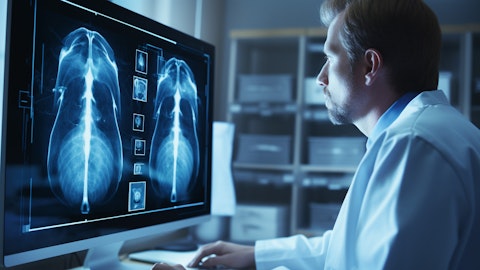Acurx Pharmaceuticals, Inc. (NASDAQ:ACXP) Q2 2025 Earnings Call Transcript August 12, 2025
Operator: Greetings, and welcome to the Acurx Pharmaceuticals to discuss second quarter 2025 Financial results Conference Call. [Operator Instructions] As a reminder, this conference is being recorded. It is now my pleasure to introduce Robert Shawah, Chief Financial Officer. Please go ahead.
Robert G. Shawah: Thank you, Stacy. Good morning, and welcome to our call. This morning, we issued a press release providing financial results and company highlights for the second quarter of 2025, which is available on our website at acurxpharma.com. Joining me today is Dave Luci, President and CEO of Acurx, who will give a corporate update and outlook. Following that, I’ll provide some highlights of the financials from the second quarter ended June 30, and then turn the call back over to Dave for his closing remarks. As a reminder, during today’s call, we’ll be making certain forward-looking statements, which are based on current information, assumptions, estimates and projections about future events that are all subject to change and involve a number of risks and uncertainties that may cause actual results to differ materially from those contained in the forward-looking statements.
Investors should consider these risks and other information described in our filings with the Securities and Exchange Commission, including our quarterly report on Form 10-Q, which we filed yesterday, Monday, August 11, 2025. You are cautioned not to place undue reliance on these forward-looking statements, and Acurx disclaims any obligation to update such statements at any time in the future. This conference call contains time-sensitive information that’s accurate only as of the date of this live broadcast today, August 12, 2025. I’ll now turn the call over to Dave. Dave?
David P. Luci: Thanks, Rob. Good morning, everyone, and thank you so much for joining us to review our financial results for the second quarter of ’25 and also to hear some recent updates. Then we’d be pleased to take any questions. First, I’d like to briefly summarize just a few of our key activities for the second quarter or in some cases, shortly thereafter. In April, we announced that the Indian Patent Office granted a new patent for our DNA polymerase IIIC inhibitors, which expires in December 2039, subject to extension. This constitutes another significant building block for our ongoing preclinical antibiotic development program of ACX-375C, which targets the treatment of infections caused by MRSA, VRE, DRSP and anthrax.
In May, we closed an equity line of credit with Lincoln Park Capital for up to $12 million of additional funding. In June, the company entered into a warrant inducement agreement with an existing warrant holder for the exercise of warrants to purchase an aggregate of 222,272 shares of the company’s common stock having a current exercise price for the Series A warrants to purchase 61,538 shares of the company’s common stock at $65 per share for Series B warrants to purchase 27,400 shares of our common stock at $65 per share and for Series C warrants to purchase 66,667 shares of our common stock at $65.20 per share and Series D warrants to purchase 66,667 shares of our common stock at an exercise price of $65.20 per share, originally issued in July ’22 and May ’23 at a reduced exercise price of $12 per share.
In consideration for the company’s agreement to issue new Series G-1 warrants to purchase up to an aggregate of 311,180 shares of common stock with a 5-year term and new Series G warrants to purchase up to an aggregate 133,363 shares of our common stock with a 5-year term from shareholder approval, each at an exercise price of $8.50 per share. The gross proceeds to the company from the exercise of the existing warrants was approximately $2.7 million with net proceeds of $2.5 million after deducting fees and expenses payable by the company. The warrant inducement transaction closed on June 20. The company will continue its multistep approach to raising capital through customary financings, warrant inducements and public-private partnership opportunities going forward.
In June, we announced the publication of our Phase IIb clinical trial data for ibezapolstat in C. difficile infection in Lancet Microbe, the world-leading microbiology research journal. This publication is available on our website at acurxpharma.com. The Lancet Microbe summary highlighted ibezapolstat’s Phase II results are as follows, “results included high rates of clinical cure in ibezapolstat- treated subjects with no recurrence. Furthermore, ibezapolstat was found to be safe, well tolerated and associated with the preservation of key health promoting bacteria responsible for bile acid homeostasis, a key component in preventing recurrent CDI.” The Lancet publication also highlighted ibezapolstat’s potential as a novel antibiotic treatment for CDI with high rates of clinical cure and sustained clinical cure while preserving and restoring the healthy gut microbiota.
The senior author, Professor Kevin Garey, PhD University of Houston and the co-author of the IDSA Infectious Disease Society of America treatment guidelines for C. difficile infection noted that current U.S. and European treatment guidelines for CDI recommends only two antibiotics for treatment, oral vancomycin or fidaxomicin. Vancomycin is most commonly used but has a low clinical cure rate of 70% to 92% and a sustained clinical cure rate of 42% to 71%, fidaxomicin has fewer recurrences but low rates of clinical cure at about 84% and sustained clinical cure at 67%. Professor Garey further noted that both marketed antibiotics for CDI are associated with emerging antimicrobial resistance, stating “The clinical need for a new antibiotic like ibezapolstat to treat CDI is underscored by a recently published study in Clinical Infectious Diseases by Dr. Curtis Donskey of the Cleveland VA and conducted in a hospital setting, documenting that C.

difficile isolates with clinically relevant reduced fidaxomicin susceptibility may emerge during therapy and spread to other patients. The medical community should be aware of this alarming finding.” Again, that’s by Dr. Garey. Also in June, we announced results from our collaboration with Leiden University Medical Center of its study of the mechanism of action of our polymerase IIIC platform of inhibitors with data presented at the Federation of American Societies for Experimental Biology Scientific Conference convened in the Netherlands on May 21. A scientific presentation was provided by Mia Urem, PhD from Leiden University Medical Center entitled A Unique Inhibitor Confirmation Selectively Targets the DNA Polymerase PolC of Gram-Positive Priority Pathogens.
This scientific conference is the premier venue for the newest research and technological trends in molecular machines in the human body that ensure DNA replication and expression of genes to create proteins that make up the cell. In August, we implemented a 1-for-20 reverse stock split in an effort to comply with the NASDAQ listing maintenance requirements. We continue to identify and pursue funding opportunities for our Phase III clinical trial program for ibezapolstat and consider alternative financial pathways to achieve success. We have several initiatives underway to this end, and we’ll report in future updates as appropriate. As we have continually reported, ibezapolstat clinical results continue to demonstrate its leadership in the field in a serious and potentially life-threatening infectious disease called C.
difficile bacteria that the U.S. CDC categorizes as an urgent threat and calls for new classes of antibiotics for initial treatment, but also have low incidence of recurrence. Ibezapolstat has FDA QIDP and Fast Track designations for the treatment of CDI. We also believe that ibezapolstat, if approved, could make a favorable economic impact by reducing the overall annual U.S. cost burden for C. diff infection of approximately $5 billion a year, of which $2.8 billion is due to recurrent infection, what we call the secondary market. With our continuing momentum and passion to achieve success for our stakeholders, we remain confident that while development of ibezapolstat’s competitive profile continues to strengthen, the best is yet to come as we navigate through these very challenging times in the macroeconomic environment and in our industry sector.
And now back to our CFO, Rob Shawah, to guide you through the highlights of our financial results for the second quarter of ’25. Rob?
Robert G. Shawah: Thanks, Dave. Our financial results for the second quarter ended June 30, 2025, were included in our press release issued earlier this morning. The company ended the quarter with cash totaling $6.1 million compared to $3.7 million as of December 31, 2024. During the second quarter, the company raised a total of approximately $3.4 million of gross proceeds through purchases under the equity line of credit and a Warrant Inducement agreement. Research and development expenses for the 3 months ended June 30 were $0.5 million compared to $1.8 million for the 3 months ended June 30, 2024, a decrease of $1.3 million. The decrease was due primarily to a decrease in manufacturing costs of $0.3 million and a decrease in consulting costs of $1 million as a result of the prior year trial-related expenses.
For the 6 months ended June 30, 2025, research and development expenses were $1.1 million versus $3.4 million for the 6 months ended June 30, 2024. The decrease of $2.3 million was primarily due to a reduction of $0.6 million in manufacturing costs and a $1.7 million decrease in consulting costs due to higher trial-related costs in the prior year. General and administrative expenses for the 3 months ended June 30, 2025, were $1.7 million compared to $2.3 million for the 3 months ended June 30, 2024, a decrease of $0.6 million. The decrease was primarily due to a $0.7 million decrease in share-based compensation, offset by a $0.1 million increase in professional fees. For the 6 months ended June 30, 2025, general and administrative expenses were $3.3 million versus $5.1 million for the 6 months ended June 30, 2024, a decrease of $1.8 million.
The decrease was due primarily to a $0.6 million decrease in professional fees and a $1.2 million decrease in share-based compensation. The company reported a net loss of $2.2 million or $1.89 per diluted share for the 3 months ended June 30, 2025, compared to a net loss of $4.1 million or $5.21 per diluted share for the 3 months ended June 30, 2024, and a net loss of $4.4 million or $4.01 per diluted share for the 6 months ended June 30, 2025, compared to a net loss of $8.5 million or $10.84 per diluted share for the 6 months ended June 30, 2024, all for the reasons previously mentioned. The company had a reverse split adjusted 1,470,352 shares outstanding as of June 30, 2025. With that, I’ll turn the call back over to Dave.
David P. Luci: Thanks, Rob, and to all of you for joining us today. And now back to our operator, Stacy, to open the call for questions. Stacy?
Q&A Session
Follow Acurx Pharmaceuticals Inc. (NASDAQ:ACXP)
Follow Acurx Pharmaceuticals Inc. (NASDAQ:ACXP)
Receive real-time insider trading and news alerts
Operator: [Operator Instructions] First question, Jim Molloy with Alliance Global Partners.
James Francis Molloy: Looking at the OpEx coming down in line certainly with cash preservation, high priority. Is this a trend we should expect to continue through the rest of ’25 and ’26? And then maybe following up on that, I know it’s a bit up in the air and a little out of your hands. But as an outsider looking in, when should we anticipate potentially either a partnership — a partnership to be signed? Is that something in ’25 — in 2025, 2026 and you’re getting these trials up and running for ibeza?
David P. Luci: Sure, Jim. I’ll start with your second question. I’ll ask you to repeat the first. But for your second question, it could be any time here in the second half in terms of a private partnership, if we’re able to announce something like that. In terms of — I use the word partnership broadly to include government agencies because that’s their preference. They like to say that they’re not providing grants. They’re entering into partnerships and they expect their incubator companies to be good partners. So that process is ongoing and will certainly slip into 2026, given the dynamics that are going on in Washington. So the federal government’s year-end is September 30. And as I understand it through the folks we work with in Washington, they’re expecting a continuing resolution toward the end of the year, kind of the usual annual one to kind of calendar year-end as being likely the time when funding for the new fiscal year gets appropriated through the — starting with the House Ways and Means Committee.
So those are all going very well, I would say, and we’re confident that we will have success in these regards overall. But I think particularly with the government, it’s going to take time. But could I ask you to ask the first question again, please?
James Francis Molloy: Yes, of course. And I see that you guys are preserving cash, operating expenses coming down nicely in line with your expectation to preserve capital. Is that something we should expect a trend we should continue through second half ’25 and into ’26?
David P. Luci: Absolutely. We’re trimming tremendously. What I would say is when you’re seeing things like G&A expenses that we report on these earnings calls, that’s a different number than cash flow. That includes cash and noncash items. So our cash burn is — it’s down to close to $400,000 a month at this point, and we expect to continue that process. Now there is some clinical strategy things that we will be announcing in the near future that we’re currently considering for a new very small clinical trial that we can handle financially without a lot of heavy lift on our end. But we’ll be able to come out with more information on that next quarter after we get in front of our Board of Directors.
James Francis Molloy: Excellent, and as always excellent work on keeping the accruals in line.
Operator: Next question comes from Matthew Keller with H.C. Wainwright.
Matthew Keller: Congrats on the quarter. So just two quick ones from us. Obviously, the publication of the IIb data was very nice. I was wondering if there were any additional feedback that you got from either physician community or KOL community on that publication. And then the second question I had for you is kind of related to maybe the previous question, but are there any other rate-limiting steps ahead of the upcoming Phase III studies that we should be thinking about?
David P. Luci: Well, thank you, Matthew, for the questions. For rate-limiting steps, the only one, and it’s not even really a long rate limit would be — as we talked about the fill/finish of the ibezapolstat supply into the Phase III trials. We’ve been reluctant to do fill/finish because once you do, then your drug is dated, and we want to forestall that to maximize the amount of time we have to use the ibezapolstat without it becoming obsolete. So that may be a couple of month process. It’s nothing significant. But everything else is literally ready. The European Medicines Agency and FDA amazingly agreed entirely on the identical same protocol for the two trials. So that’s gone quite well.
Operator: There are no further questions. This does conclude today’s teleconference. Thank you for your participation. You may now disconnect your lines.
David P. Luci: Thank you, Stacy.
Follow Acurx Pharmaceuticals Inc. (NASDAQ:ACXP)
Follow Acurx Pharmaceuticals Inc. (NASDAQ:ACXP)
Receive real-time insider trading and news alerts




